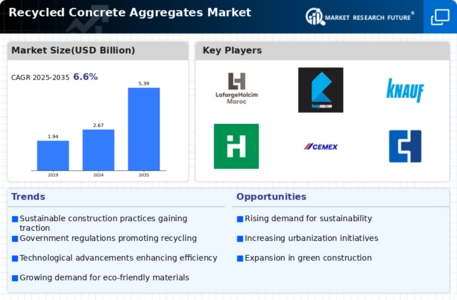The Recycled Concrete Aggregates Market is currently characterized by a dynamic competitive landscape, driven by increasing environmental regulations and a growing emphasis on sustainable construction practices. Major players such as LafargeHolcim (CH), CRH (IE), and HeidelbergCement (DE) are strategically positioning themselves to capitalize on these trends. LafargeHolcim (CH) has focused on innovation in recycling technologies, enhancing the quality of recycled aggregates, while CRH (IE) has pursued regional expansion through acquisitions, thereby increasing its market footprint. HeidelbergCement (DE) emphasizes digital transformation, integrating advanced analytics into its operations to optimize resource use and improve efficiency. Collectively, these strategies not only enhance their competitive edge but also contribute to a more sustainable industry framework.
In terms of business tactics, companies are increasingly localizing manufacturing to reduce transportation costs and carbon footprints. Supply chain optimization remains a critical focus, as firms seek to enhance operational efficiency and responsiveness to market demands. The market structure appears moderately fragmented, with several key players exerting influence while also allowing for smaller firms to thrive. This fragmentation fosters innovation and competition, as companies strive to differentiate themselves through unique offerings and sustainable practices.
In August 2025, LafargeHolcim (CH) announced a partnership with a leading technology firm to develop a new recycling process that significantly reduces energy consumption. This strategic move is likely to enhance their operational efficiency and align with global sustainability goals, positioning them as a leader in eco-friendly construction materials. The partnership underscores the importance of technological innovation in maintaining competitive advantage in the recycled aggregates sector.
In September 2025, CRH (IE) completed the acquisition of a regional recycled aggregates company, which is expected to bolster its market presence in the North American region. This acquisition not only expands CRH's operational capacity but also enhances its ability to meet the increasing demand for sustainable construction materials. Such strategic acquisitions are indicative of a broader trend where companies seek to consolidate their positions in key markets, thereby enhancing their competitive leverage.
In October 2025, HeidelbergCement (DE) launched a new digital platform aimed at improving the traceability and quality assurance of recycled aggregates. This initiative reflects a growing trend towards digitalization in the construction materials sector, where data-driven insights can lead to better decision-making and enhanced product quality. By investing in digital solutions, HeidelbergCement is likely to set new standards in the industry, further solidifying its competitive position.
As of October 2025, the competitive landscape is increasingly shaped by trends such as digitalization, sustainability, and the integration of artificial intelligence. Strategic alliances are becoming more prevalent, as companies recognize the value of collaboration in driving innovation and enhancing operational capabilities. Looking ahead, competitive differentiation is expected to evolve from traditional price-based competition towards a focus on innovation, technological advancements, and supply chain reliability. This shift may redefine market dynamics, compelling companies to invest in sustainable practices and cutting-edge technologies to maintain their competitive edge.

















Leave a Comment